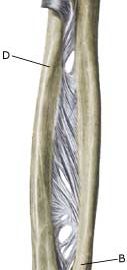|
||
|
||
| Cause: A bone fracture can occur in cases of a direct blow or fall on the arm, and can occur anywhere on the bone. It is often seen in children that the bone merely “bends” (green-stick fracture).
Symptoms: Sudden pain and pain induced constriction of movement of the arm after a fall or blow. An angling of the forearm can occasionally be seen. In rare case, acute compartment syndrome can develop. Acute treatment: Click here. Examination: Sudden, powerful pains in the arm with constriction of movement after a fall, should always lead to acute medical examination. The fracture is usually visible on x-rays, and on the basis of the type of fracture, the correct treatment can be determined. Treatment: In cases of considerable dislocation or angling of the bones, the fracture will be reset under an anaesthetic, followed by bandaging for a few weeks. In certain types of fractures, an operative fixation can be necessary. Rehabilitation: When pain has decreased fitness training in the form of cycling may be started along with rehabilitation as specified under rehabilitation, general. The rehabilitation period is completely dependent upon the type of fracture and the treatment administered. Bandage: Special plastic bandages can be made for use following a fracture of the forearm when sports are resumed. Complications: In the vast majority of cases the fracture heals without complications, although in some cases a poor healing occurs which can affect the blood vessel and the nerve supply to the arm, resulting in chronic compartment syndrome. If satisfactory progress is not achieved, you should therefore consult your doctor. |


